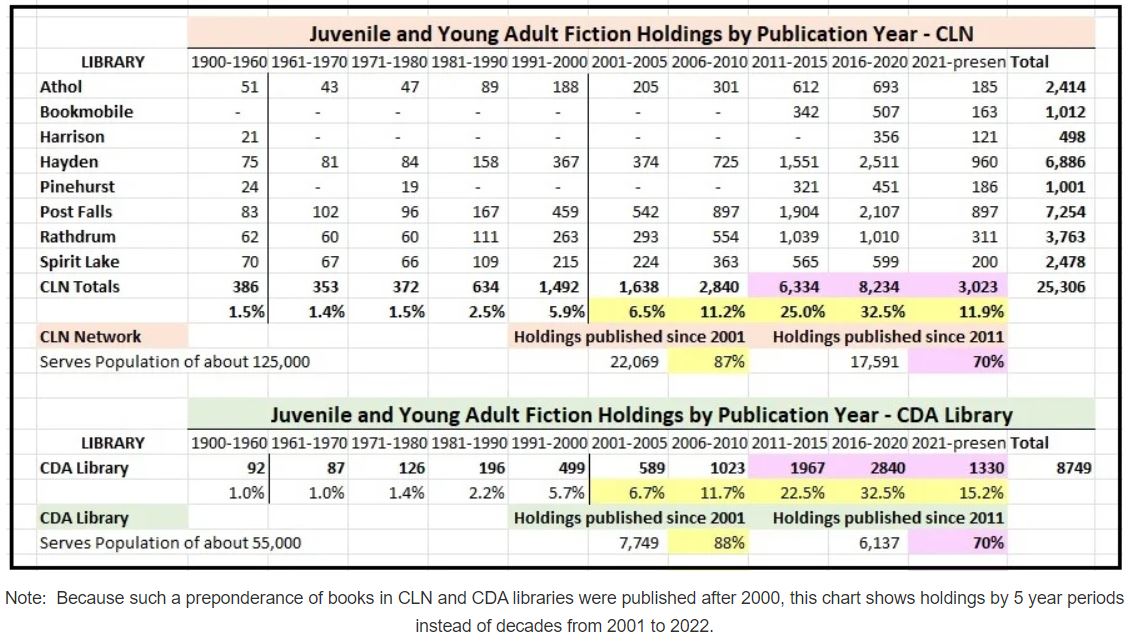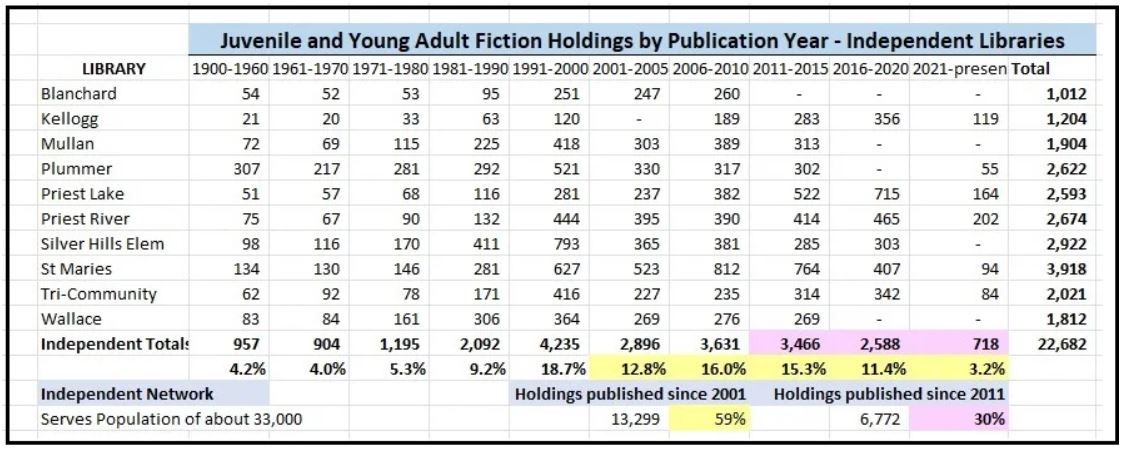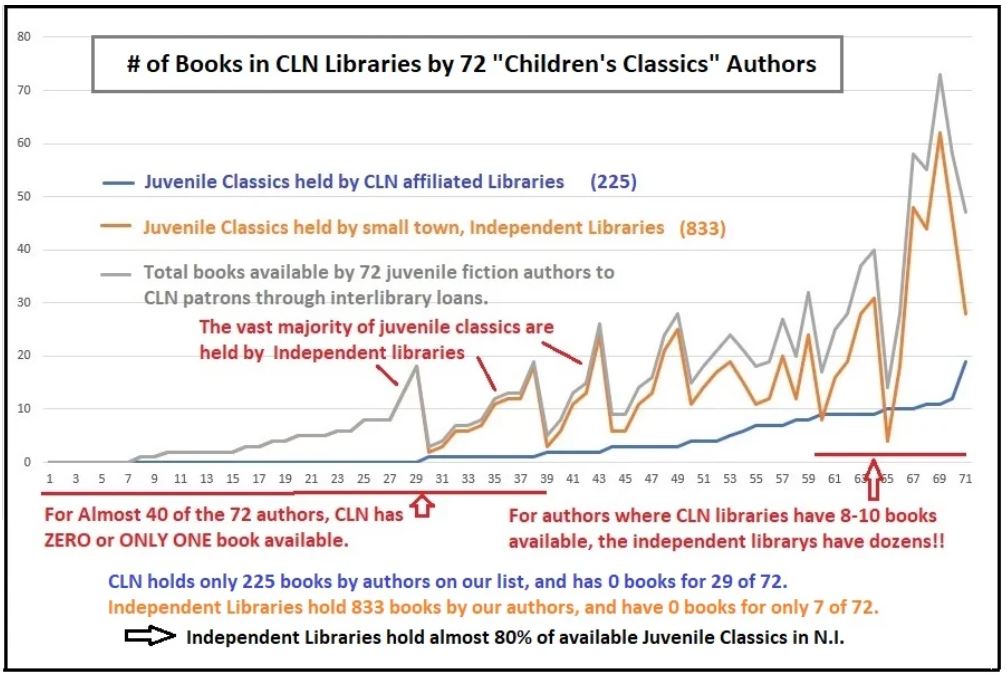
Wrecked Libraries—Dumping Classics, Pumping Trash
By North Idaho Slow Growth Research
Our Lost Literary Legacy
“The past was erased, the erasure was forgotten, the lie became the truth.” —George Orwell, 1984
Almost thirty years ago we decided to homeschool and began collecting traditional children’s books. At that time high quality children’s literature could easily be found at used book stores, thrift shops, and yard sales so we were able to amass an impressive collection of juvenile classics, composed mainly of library discards. Many other homeschool families did the same.
But our good fortune in building up our private book collections came at a high cost to those who rely on libraries for their reading selections. The reason we could so easily build up our home library was because during the 1990s, libraries nationwide began tossing out high quality, classical children books. Many people are aware of the problem of “explicitly sexual” materials being made available for minors, but the problems in our libraries go much deeper.
As horrifying and obviously inappropriate as the “porn” in our libraries is, it is only a symptom of a much bigger problem. Even if all “inappropriate” and obviously pornographic trash was removed from our local libraries, the quality of most of the children’s books that remain would still be appalling. Most of the literary treasures that once filled our library shelves have already been consigned to the trash heap; and the judgment of those who purchase new material is abominable.
The CLN leaders who transformed our regional libraries from literary, informational, and cultural centers to toxic cesspools, were not acting alone. For two decades it has been apparent that public libraries nationwide have been casting out good quality, traditional children’s literature, and stocking their shelves with moronic, degenerate, soul-killing, teeny bopper trash.
This was intentional. Our children’s literary heritage has been deliberately destroyed as part of a globalist scheme to undermine American culture and remake libraries into “Social Service” providers, staffed by left-wing activists. It is a nationwide problem, but it is most acute in large library systems run by certified administrators associated with the radical “American Library Association.”
Evidence of Juvenile Classics Missing from CLN Libraries
We have long known that libraries systems such as CLN have been dumping and discarding quality juvenile literature for many years. But how does one PROVE the charge of “classics dumping?” With some help from another mother from the Clean Books for Kids group, it was surprisingly easy.
In order to quantify the problem, and make sure we were making fair comparisons, we focused only on Juvenile and Young Adult literature, rather than easy readers or non-fiction. Our initial inspection of the juvenile fiction shelves in Hayden proved beyond a doubt that very little classical literature remained on the CLN shelves. A hand count of the volumes available on the teen fiction shelf found that almost the entire collection was published after 2000 and there were extremely few recognizable authors or titles.
But we needed to back up our in-person inspection with objective data. In order to demonstrate these problems, we took two different tactics.
- We used CLN’s online catalog to calculate the total number of juvenile and young adult fiction books in CLN libraries sorted by decade. That is, we counted the number of books in the CLN system published between 1970-79, 1980-89, 1990-99, 1991-2000, 2001-10, 2011-20, etc.
- Using “recommended reading” lists of children’s literature from thirty years ago we made up a list of seventy popular pre-1990 juvenile fiction authors. We then used the CLN online catalog to check the availability of books by these authors.
Both of our investigations turned up overwhelming evidence that under the leadership of Judy Meyer and her globalist cohorts, CLN has ditched almost its entire collection of quality juvenile literature.
“Independent” Libraries of North Idaho
What we did not fully understand until after we had already begun our study, was that the CLN online catalog allowed patrons to access books both inside and outside the CLN system. There is a regional group of libraries known as the “Cooperative Information Network” (CIN) that includes dozens of local, independently governed libraries, in addition to CLN libraries. So in addition to surveying the holdings of the eight libraries in CLN’s network, we were able to access the inventories of about a dozen small-town libraries in Benewah, Shoshone, and West Bonner County.
And what became immediately apparent, as we investigated their holdings of juvenile literature, was that these small, independent libraries had a far, far better selection of children’s classics than did the CLN affiliated libraries.
It was surprising to see what an impressive collection of children’s classics some of these small, independent libraries still had. Some were located in towns of only a few thousand people, yet had a substantial collection of quality children’s literature. It almost seems that small town libraries, firmly under the control of local citizens, did not participate in the systematic destruction of the literary heritage of their children that has clearly occurred in larger, urban libraries.
Once we saw that the small independent libraries were the true source of most quality classical juvenile literature in North Idaho, we revamped our analysis to provide for a side-by-side comparison of the CLN vs. Independent library offerings. The comparison is striking and provides positive proof that CLN has systematically ditched most of its inventory of classical children’s authors.
Holding the Classics vs. Heaving the Classics
The following charts provide a clear contrast between the systematic destruction of our young people’s literary legacy in Kootenai’s library Districts, and the preservation of juvenile classics that prevails in small town libraries. We’ve compared statistics from the holdings from the following library systems:

The following chart shows the distribution of books in the Juvenile and Young adult sections of the CLN and CDA Libraries. Notice that the distribution of books over decades is extremely similar, and both show a preponderance of books published after the year 2000. In both library systems over 87% of available juvenile fiction has been published within the last 20 years, and over 70% in just the last 12 years.
The vast majority of these recently published books are by unknown authors that parents cannot possibly be familiar with, and many are pandering, sensational, edgy, or transgressive, with almost no literary merit. After a few years on the shelves, most are simply removed to the discard shelves to free up space to import hundreds more new, unknown, low-quality volumes.

Note: Because such a preponderance of books in CLN and CDA libraries were published after 2000, this chart shows holdings by 5 year periods instead of decades from 2001 to 2022.
Our next chart shows the same data from North Idaho Independent Libraries, whose selection of books is not determined by CLN or CDA library board members. The distribution of books in these libraries over time is far more balanced, with every decade prior to 2000 showing in real numbers (not just percentages) MORE juvenile classics in North Idaho’s small town, independent libraries, than in both CDA and CLN library systems put together. <<<< This is a scandal.

Who is Really “Banning” Books?
The above charts show an overwhelming bias towards modern literature in the juvenile selection in CLN libraries, but what exactly is being thrown out? At the Library Town Hall, Judy Meyer argued that certain books were removed from the library because they took up shelf space and “didn’t pay their rent”. What are these books that no longer seem to exist in the CLN system?
In order to investigate this, we created a list of about 70 moderately well-known juvenile fiction authors who were published between 1900 and 1990. In every case their books had been in print for at least ten years, and sometimes nearly a century, and all were commonly found on “recommended reading lists” by traditional librarians. A list of the authors we selected and the number of their books that still exist in both the CLN system and the Non CLN, “Independent” network: can be found HERE.
In the following chart the authors are sorted first by the number of their books in the CLN system and then by the number of their book in the Independent library network.

The blue line shows the number of books in the CLN network. For 40 of the 72 books shown above, CLN had either zero or just one copy of the classic author. Seven of the 72 authors were absent from both CLN and Independent networks, but for almost all the rest of the authors, the Independent network had on average, 4 times as many of the authors’ books as the CLN network.
What this means, is that, although there are hundreds of classical children’s books in CLN’s online system, almost 80% of them are not actually in CLN libraries. If a parent makes a special request for a favorite book through the CLN system, they may very well get access via an “interlibrary loan”, but they will actually be borrowing the book from a small town library.
Much worse, however, is that the books will never appear on CLN library shelves and young people who browse the stacks in Hayden, Post Falls, or any other CLN library will never be exposed to these books, or be aware that they are options. All they will see is shelves full of degrading, meritless, modernist garbage, pushed by CLN globalist minions.
Only parents who already know about these treasures of youth literature will request them. Eventually they will all be forgotten. That was the plan all along. Or to paraphrase George Orwell.
“Our children’s literary heritage was erased, the erasure was forgotten, and degrading modernist drivel became the culture.”
Removing Pornography is Just a Start
The problem that those of us who love books and literature are facing is that a great deal of our literary heritage has already been wiped out and it is not easily retrievable. The Community Library Network has been a noxious and destructive influence on Kootenai libraries from the beginning. Almost all of the libraries in Kootenai County would have been far better off if they had stayed under the control of local townspeople.
Rebuilding a decayed and degenerated library system into a worthwhile asset to the community will not be easy and cannot be done quickly, but it is possible. As with everything worth doing, it will take time and persistence. Removing the Porn Pushing, Globalist leaders who currently hold sway over the CLN Network will not solve all of the libraries’ problems, and will likely lead to conflict, protests, and possibly law suits by those forces who do not want to give up control of an 8 million dollar per year cash cow. But its a great first step.
And step by step, book by book, election by election, we WILL protect our children’s innocence and reclaim our libraries and literary heritage.
Published with permission of nislowgrowth.org